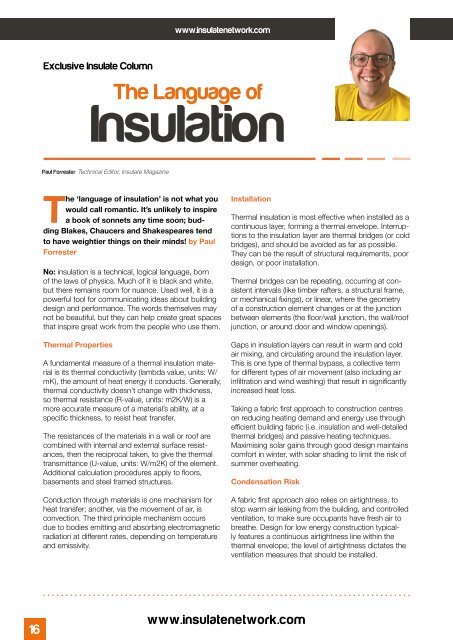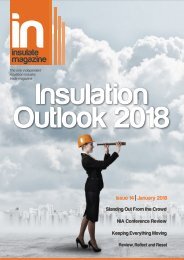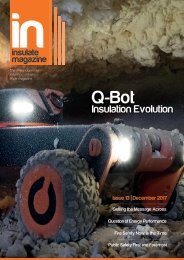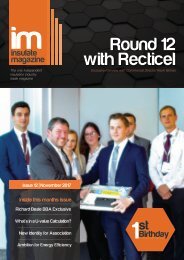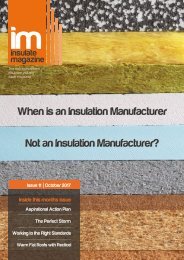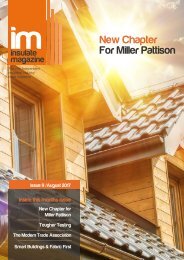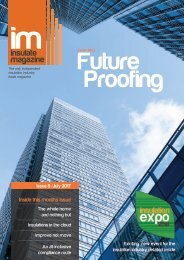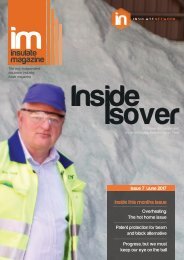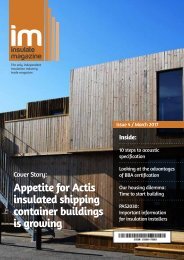Insulate Magazine Issue 17
Create successful ePaper yourself
Turn your PDF publications into a flip-book with our unique Google optimized e-Paper software.
www.insulatenetwork.com<br />
Exclusive <strong>Insulate</strong> Column<br />
The Language of<br />
Insulation<br />
Paul Forrester Technical Editor, <strong>Insulate</strong> <strong>Magazine</strong><br />
The ‘language of insulation’ is not what you<br />
would call romantic. It’s unlikely to inspire<br />
a book of sonnets any time soon; budding<br />
Blakes, Chaucers and Shakespeares tend<br />
to have weightier things on their minds! by Paul<br />
Forrester<br />
No: insulation is a technical, logical language, born<br />
of the laws of physics. Much of it is black and white,<br />
but there remains room for nuance. Used well, it is a<br />
powerful tool for communicating ideas about building<br />
design and performance. The words themselves may<br />
not be beautiful, but they can help create great spaces<br />
that inspire great work from the people who use them.<br />
Thermal Properties<br />
A fundamental measure of a thermal insulation material<br />
is its thermal conductivity (lambda value, units: W/<br />
mK), the amount of heat energy it conducts. Generally,<br />
thermal conductivity doesn’t change with thickness,<br />
so thermal resistance (R-value, units: m2K/W) is a<br />
more accurate measure of a material’s ability, at a<br />
specific thickness, to resist heat transfer.<br />
The resistances of the materials in a wall or roof are<br />
combined with internal and external surface resistances,<br />
then the reciprocal taken, to give the thermal<br />
transmittance (U-value, units: W/m2K) of the element.<br />
Additional calculation procedures apply to floors,<br />
basements and steel framed structures.<br />
Conduction through materials is one mechanism for<br />
heat transfer; another, via the movement of air, is<br />
convection. The third principle mechanism occurs<br />
due to bodies emitting and absorbing electromagnetic<br />
radiation at different rates, depending on temperature<br />
and emissivity.<br />
Installation<br />
Thermal insulation is most effective when installed as a<br />
continuous layer, forming a thermal envelope. Interruptions<br />
to the insulation layer are thermal bridges (or cold<br />
bridges), and should be avoided as far as possible.<br />
They can be the result of structural requirements, poor<br />
design, or poor installation.<br />
Thermal bridges can be repeating, occurring at consistent<br />
intervals (like timber rafters, a structural frame,<br />
or mechanical fixings), or linear, where the geometry<br />
of a construction element changes or at the junction<br />
between elements (the floor/wall junction, the wall/roof<br />
junction, or around door and window openings).<br />
Gaps in insulation layers can result in warm and cold<br />
air mixing, and circulating around the insulation layer.<br />
This is one type of thermal bypass, a collective term<br />
for different types of air movement (also including air<br />
infiltration and wind washing) that result in significantly<br />
increased heat loss.<br />
Taking a fabric first approach to construction centres<br />
on reducing heating demand and energy use through<br />
efficient building fabric (i.e. insulation and well-detailed<br />
thermal bridges) and passive heating techniques.<br />
Maximising solar gains through good design maintains<br />
comfort in winter, with solar shading to limit the risk of<br />
summer overheating.<br />
Condensation Risk<br />
A fabric first approach also relies on airtightness, to<br />
stop warm air leaking from the building, and controlled<br />
ventilation, to make sure occupants have fresh air to<br />
breathe. Design for low energy construction typically<br />
features a continuous airtightness line within the<br />
thermal envelope; the level of airtightness dictates the<br />
ventilation measures that should be installed.<br />
16 16<br />
www.insulatenetwork.com


